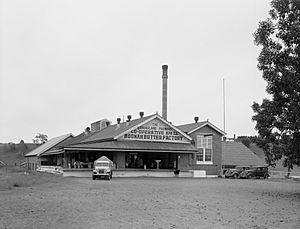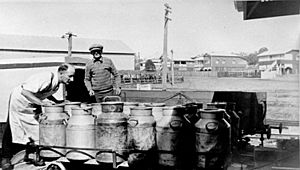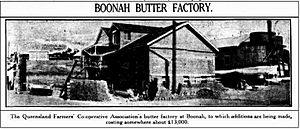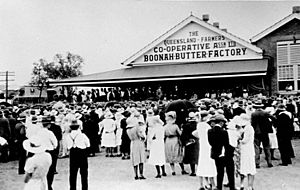Boonah Butter Factory facts for kids
Quick facts for kids Boonah Butter Factory |
|
|---|---|
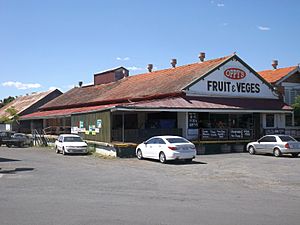
Part of the site is currently a shop
|
|
| Type | food production |
| Location | Boonah |
| Built | July 1916, January 1933 |
| Built for | Dairy products |
| Current use | store, art studio and gallery |
| Architect | Robert Kerr, Duncan Saxelby, T.R Hall and Phillips |
| Lua error in Module:Location_map at line 420: attempt to index field 'wikibase' (a nil value). | |
The Boonah Butter Factory is a very old and important building in Boonah, Australia. It was built in 1916. For many years, it was one of the most modern butter factories in the whole Commonwealth. It was also the biggest butter factory in the Southern Hemisphere! It made the second most butter in Queensland and sent lots of dairy products to Brisbane.
This factory was super important for the Boonah area. It helped show how much the region was growing. It even made and supplied electricity to Boonah and pumped water for fighting fires. Today, the Boonah Butter Factory is the only old cream or butter factory left in Boonah. It's now used as a place for art studios and galleries. The old loading area is even a fruit and vegetable shop!
Contents
History of Boonah's Dairy Industry
Dairy farming was a huge part of Boonah's early success. It helped the town become rich and stable. The first creamery in Boonah was built around 1894. A creamery is a place where milk is processed to separate the cream. This cream was then sent by train to bigger factories in Brisbane to be made into butter. The leftover milk was used to feed pigs, which was another important farm product in the area.
By 1895, the creamery was sold to the Lowood Creamery Company. They owned several creameries in the region.
Farmers Take Control
Even though the creameries were doing well, local farmers wanted more control over their dairy products. They wanted to make butter right there in Boonah. This would stop the cream from being shaken too much on the train ride to Brisbane. Farmers also wanted to be part of a "cooperative" movement. This meant they would own and run the factory together, instead of relying on private companies.
The early dairy factories encouraged farmers to improve their milk. The success of farming in the area was also linked to the Boonah Showgrounds. This is where the annual Boonah Show is held. It's a place to show off local produce and bring the community together.
First Butter Factory in Boonah
The first factory built just for making butter in Boonah opened in 1900. It was called the Fassifern Butter Factory and Ice Works. It collected milk from the smaller creameries nearby.
However, the local farmers were still not happy with the private owners. So, in 1905, two farmer groups decided to work together. They were the Boonah Farmers Co-Operative Dairy Co. and the Queensland Farmers Co-Operative Association. They bought the Fassifern Butter Factory in 1907.
Building the New Factory
Within ten years, the old factory was too small and not in a good spot. So, a new location was chosen in 1914. This new spot was perfect because it was right next to the railway station. This made it easy to transport cream and butter.
The new factory was a modern building made of brick with concrete floors. It even had its own railway line and platform! The plans were drawn by Robert Kerr, an architect famous for building many butter factories in Australia.
The new Boonah Butter Factory was filled with the latest equipment. It officially opened in July 1916. The Governor of Queensland, Sir Hamilton Goold-Adams, came to open it.
Award-Winning Butter
The dairy products from Boonah were known for being very good. In 1931, the salted butter from the Boonah Butter Factory won first prize at the London Dairy Show! By the 1930s, the factory had 900 farmers supplying it with cream. Even the Prime Minister of Australia, Mr Joseph Lyons, mentioned how good Boonah butter was during a visit in 1938.
Factory Expansion
In 1932, plans were made to make the butter factory much bigger. The new parts were designed to match the old building. The floors were redone with tiles, and new steel beams were put in to support the upper floor.
The additions were designed by Thomas Ramsay Hall, an architect who also designed the famous Brisbane City Hall. The expanded factory officially opened in January 1933.
Later, in 1954, the factory started making a new product: buttermilk powder!
Factory Closes Down
The Boonah Butter Factory closed its doors on March 1, 1974. This happened because milk prices were low, and farming methods in the area were changing. The last batch of butter was made that day. After it closed, milk from Boonah was sent to another factory in Booval for processing.
The Boonah Butter Factory is the only big industrial building left from the dairy, timber, and railway industries in Boonah from the 1800s and 1900s. Other important places, like the Cossart's Mill (a sawmill) and the railway line, have since closed down or been removed.
Today, the Boonah Butter Factory is part of a group of old butter factories in South East Queensland that have been given new life. They are now used for cultural events or community activities.
Images for kids


